日志
防电击
热度 4 |||
防电击
电是客观存在的,例如雷电、摩擦生电!20世纪以来电得到了极大的推广,当大家享受电给带来的方便、舒适的同时,由于对电知识缺乏,因此,发生了许多由于电所造成的灾难,而伴随着许多学者对电的不断探索了解,总结出了很多经验并汇集成了标准及规范,从而能够很好的指导大家有效安全的利用电力,为大家创造和谐、舒适的生活环境。
随着欧洲经济的发展及电力的推广,人们越来越意识到安全用电的重要性,1907年,国际电工委员会(IEC)正式成立,该机构主要责任在于制定适合国情及经济能够促进紧急发展、控制危险程度的标准,推动经济的健康发展。世界各国经济发展都比较落后于欧洲经济(除北美贸易区建立自己的标准),因此,为了促进生产力的发展并节约资源,基本等同采用IEC标准,部分国家考虑到本国的基本国情:人文素质、环境、经济发展水平,对IEC标准做了部分调整后作为本国标准。
PS:某些等同采用的IEC标准因为没考虑到基本国情、人文素质、环境、经济发展水平,造成实际生产力与标准不匹配的矛盾,从而给经济发展带来了一定的负面影响。
定义
带电体
在正常使用载流的导体及导电件,包括零线,但不包含PEN线。
3.6.4
live part
conductor or conductive part intended to be energized in normal use, including a neutral
conductor but, by convention, not a PEN conductor
特低电压
当器具供给额定电压,导体间及导体与地之间的电压不超过50V
extra-low voltage
voltage supplied from a source within the appliance that does not exceed 50 V between
conductors and between conductors and earth when the appliance is supplied at rated
voltage
安全特低电压
供电段以安全隔离变压器或在其它双重绝缘或者加强绝缘获得,带载导体及导体与地之间电压不超过42V,空载不超过50V
voltage not exceeding 42 V between conductors and between conductors and earth, the no-load
voltage not exceeding 50 V
When safety extra-low voltage is obtained from the supply mains, it is to be through a
safety isolating transformer or a convertor with separate windings, the insulation of which
complies with double insulation or reinforced insulation requirements.
0类器具
仅仅依赖于基本绝缘的器具。
class 0 appliance
appliance in which protection against electric shock relies upon basic insulation only, there
being no means for the connection of conductive accessible parts, if any, to the protective
conductor in the fixed wiring of the installation, reliance in the event of a failure of the basic
insulation being placed upon the environment
0I类器具
供电段无接地,器具接地。
class 0I appliance
appliance having at least basic insulation throughout and incorporating an earthing terminal
but having a supply cord without earthing conductor and a plug without earthing contact
I类器具
不仅仅依靠基本绝缘,还有附加接地措施
class I appliance
appliance in which protection against electric shock does not rely on basic insulation only
but which includes an additional safety precaution, in that conductive accessible parts are connected to the protective earthing conductor in the fixed wiring of the installation in such a
way that conductive accessible parts cannot become live in the event of a failure of the
basic insulation
II类器具
依靠加强绝缘或双重绝缘防电击,没接地
class II appliance
appliance in which protection against electric shock does not rely on basic insulation only
but in which additional safety precautions are provided, such as double insulation or
reinforced insulation, there being no provision for protective earthing or reliance upon
installation conditions
III类器具
依靠加强绝缘或双重绝缘隔离后的电源,没接地
class III appliance
appliance in which protection against electric shock relies on supply at safety extra-low
voltage and in which voltages higher than those of safety extra-low voltage are not
generated
不可拆卸部件
必须通过工具才能拆除或打开,或者满足22.11的测试
3.6.1
non-detachable part
part that can only be removed or opened with the aid of a tool or a part that fulfils the test of
22.11
可拆卸部件
使用工具才能拆卸或者按说明书可以拆卸或打开的部件及不满足22.11的测试的部件
3.6.2
detachable part
part that can be removed or opened without the aid of a tool, a part that is removed or
opened in accordance with the instructions for use, even if a tool is needed for removal, or a
part that does not fulfil the test of 22.11
可触及的部件
通过probe B of IEC 61032触及的部件或表面
accessible part
part or surface that can be touched by means of test probe B of IEC 61032, and if the part or
surface is metal, any conductive part connected to it
PS: 欧美要求双重保护,所以0类、0I类器具基本不得在欧美销售; 0类、0I类器具只能在一些小国家销售。
60335依据:
6.1: Class 0 appliances and class 0I appliances are not allowed (Australia, Austria, Belgium, Czech Republic,
Finland, France, Germany, Greece, Hungary, India, Israel, Ireland, Italy, Netherlands, New Zealand, Norway,
Poland, Singapore, Slovakia, Sweden, Switzerland, United Kingdom, Yugoslavia).
防电击评定:
8防电击
8.1器具结构及外壳能保证防触电。
按8.1.1 至 8.1.3测试,并考虑8.1.4 和 8.1.5检查是否复合。
8.1.1 8.1 适合拆除可拆卸部件以后正常使用器具的所有位置。
备注:不包括不使用工具即可触及的螺纹类的保险丝及微型断路器。
Test probe B of IEC 61032(弯指)
I类设备测试弯指不能碰到带电体,II类器具只能碰到双重保护的部件。
Test probe 13 of IEC 61032(测试肖)
0类、II类器具、II类结构不能碰到带电体
test probe 41 of IEC 61032(发热零部件)
8.1.5 安装前部件需要提供基本绝缘。
8 Protection against access to live parts
8.1 Appliances shall be constructed and enclosed so that there is adequate protection
against accidental contact with live parts.
Compliance is checked by inspection and by the tests of 8.1.1 to 8.1.3, as applicable, taking
into account 8.1.4 and 8.1.5.
8.1.1 The requirement of 8.1 applies for all positions of the appliance when it is operated as
in normal use, and after the removal of detachable parts.
NOTE This excludes the use of screw-type fuses and screw-type miniature circuit breakers that are accessible
without the aid of a tool.
Lamps located behind a detachable cover are not removed, provided that the appliance can
be isolated from the supply mains by means of a plug or an all-pole switch. However, during
insertion or removal of lamps which are located behind a detachable cover, protection
against contact with live parts of the lamp cap shall be ensured.
Test probe B of IEC 61032 is applied with a force not exceeding 1 N, the appliance being in
every possible position except that appliances normally used on the floor and having a mass
exceeding 40 kg are not tilted. Through openings, the test probe is applied to any depth that
the probe will permit and is rotated or angled before, during and after insertion to any
position. If the opening does not allow the entry of the probe, the force on the probe in the
straight position is increased to 20 N. If the probe then enters the opening, the test is
repeated with the probe in the angled position.
It shall not be possible to touch live parts or live parts protected only by lacquer, enamel,
ordinary paper, cotton, oxide film, beads, or sealing compound except self-hardening resins,
with the probe.
8.1.2 Test probe 13 of IEC 61032 is applied with a force not exceeding 1 N through openings
in class 0 appliances, class II appliances and class II constructions, except for those
giving access to lamp caps and live parts in socket-outlets.
NOTE Appliance outlets are not considered to be socket-outlets.
The test probe is also applied through openings in earthed metal enclosures having a nonconductive
coating such as enamel or lacquer.
It shall not be possible to touch live parts with the test probe.
8.1.3 Instead of test probe B and test probe 13, for appliances other than those of class II,
test probe 41 of IEC 61032 is applied with a force not exceeding 1 N to live parts of visibly
glowing heating elements, all poles of which can be disconnected by a single switching
action. It is also applied to parts supporting such elements, provided that it is obvious from
the outside of the appliance, without removing covers and similar parts, that these supporting
parts are in contact with the element.
It shall not be possible to touch these live parts.
NOTE For appliances provided with a supply cord and without a switching device in their supply circuit, the
withdrawal of the plug from a socket-outlet is considered to be a single switching action.
– 32 – 60335-1/FDIS c IEC
8.1.4 An accessible part is not considered to be live if
– the part is supplied at safety extra-low voltage, provided that
• for a.c., the peak value of the voltage does not exceed 42,4 V;
• for d.c., the voltage does not exceed 42,4 V;
or
– the part is separated from live parts by protective impedance.
If protective impedance is used, the current between the part and the supply source shall
not exceed 2 mA for d.c., its peak value shall not exceed 0,7 mA for a.c. and
– for voltages having a peak value over 42,4 V up to and including 450 V, the capacitance
shall not exceed 0,1 ìF;
– for voltages having a peak value over 450 V up to and including 15 kV, the discharge shall
not exceed 45 ìC;
– for voltages having a peak value over 15 kV, the energy in the discharge shall not exceed
350 mJ.
Compliance is checked by measurement, the appliance being supplied at rated voltage.
Voltages and currents are measured between the relevant parts and each pole of the supply
source. Discharges are measured immediately after the interruption of the supply. The
quantity of electricity and energy in the discharge is measured using a resistor having a
nominal non-inductive resistance of 2 000 Ù.
NOTE 1 Details of a suitable circuit for measuring the current are given in Figure 4 of IEC 60990.
NOTE 2 The quantity of electricity is calculated from the sum of all areas recorded on the voltage/time graph
without taking voltage polarity into account.
8.1.5 Live parts of built-in appliances, fixed appliances and appliances delivered in
separate units, shall be protected at least by basic insulation before installation or assembly.
Compliance is checked by inspection and by the test of 8.1.1.
8.2 Class II appliances and class II constructions shall be constructed and enclosed so
that there is adequate protection against accidental contact with basic insulation and metal
parts separated from live parts by basic insulation only.
It shall only be possible to touch parts which are separated from live parts by double
insulation or reinforced insulation.
Compliance is checked by inspection and by applying test probe B of IEC 61032 in
accordance with the conditions specified in 8.1.1.
Test probe B of IEC 61032 is applied to built-in appliances and fixed appliances only after
installation.
这里涉及到几个问题:
ELV/SELV/NTV
漏电流测试
测试参考《IEC60990 Methods of measurement of touch current and protective conductor current》
接触电流
接触设备之后通过人体或动物的电流。
touch current
electric current through a human body or through an animal body when it touches one or more
accessible parts of an installation or of equipment
保护导体电流
protective conductor current
current which flows in a protective conductor
限值参见:60335。
影响因子:Y电容、分布电容
参见下 《某电子设备接触电流偏大的原因分析及解决方法-周会芬》
人体模拟网络、感知、反应、摆脱及电酌伤限值都可以参考这个标准去找相关资料。
爬漏电及穿透绝缘
电隙间隙
空气间两导体之间的最短距离。
clearance
shortest distance in air between two conductive parts or between a conductive part and the
accessible surface
爬电距离
两导体沿绝缘材料表面之间的最短距离。
creepage distance
shortest distance along the surface of insulation between two conductive parts or between a
conductive part and the accessible surface
电隙间隙影响量
过电压类别/污染等级/最高工作电压
过电压种类
过电压种类主要跟产品使用环境有关系,建筑物防雷标准参考GB50057-2010防雷设计规范设计,设置了外部防雷和内部防雷。
外部防雷装置主要由接闪器、引下线、接地组成。
内部防雷:最主要由SPD、气体放电管、压敏电阻、二极管、TVS管等。
研究表明雷电直击电流大约在200KA,能量非常大,主要以云地雷及片状雷存在。
因此为了保护建筑内的设备不受雷电 破坏,在添加了外部防雷后,因为电缆会分流100KA左右的雷电电流,因此需要在各个电缆入口添置电源类SPD及信号SPD。根据外部防雷及内部防雷的保护分为如下区域,随着保护区域往建筑物内编号越来越大,选择不同的SPD对各个端口的浪涌电压进行抑制,各级SPD的级间配合需要配合好,那么,设备需要耐受的过电压越小,及过电压等级也越小。
器具过电压分类参考Annex K
Annex K
(normative)
Overvoltage categories
The following information on overvoltage categories is extracted from IEC 60664-1.
Overvoltage category is a numeral defining a transient overvoltage condition.
Equipment of overvoltage category IV is for use at the origin of the installation.
NOTE 1 Examples of such equipment are electricity meters and primary overcurrent protection equipment.
Equipment of overvoltage category III is equipment in fixed installations and for cases where
the reliability and the availability of the equipment is subject to special requirements.
NOTE 2 Examples of such equipment are switches in the fixed installation and equipment for industrial use with
permanent connection to the fixed installation.
Equipment of overvoltage category II is energy consuming equipment to be supplied from the
fixed installation.
NOTE 3 Examples of such equipment are appliances, portable tools and other household and similar loads.
If such equipment is subjected to special requirements with regard to reliability and
availability, overvoltage category III applies.
Equipment of overvoltage category I is equipment for connection to circuits in which measures
are taken to limit transient overvoltages to an appropriately low level.
污染等级
跟产品应用环境有关系
参看Annex M
Annex M
(normative)
Pollution degree
The following information on pollution degrees is extracted from IEC 60664-1.
• Pollution
The microenvironment determines the effect of pollution on the insulation. The macroenvironment,
however, has to be taken into account when considering the microenvironment.
Means may be provided to reduce pollution at the insulation under consideration by effective
use of enclosures, encapsulation or hermetic sealing. Such means to reduce pollution may
not be effective when the equipment is subjected to condensation or if in normal use, it
generates pollutants itself.
Small clearances can be bridged completely by solid particles, dust and water and therefore
minimum clearances are specified where pollution may be present in the microenvironment.
NOTE 1 Pollution will become conductive in the presence of humidity. Pollution caused by contaminated water,
soot, metal or carbon dust is inherently conductive.
NOTE 2 Conductive pollution by ionized gases and metallic depositions occur only in specific instances, for
example in arc chambers of switchgear or controlgear and is not covered by IEC 60664-1.
• Degrees of pollution in the microenvironment
For the purpose of evaluating creepage distances, the following four degrees of pollution in
the microenvironment are established:
– pollution degree 1: no pollution or only dry, non-conductive pollution occurs. The pollution
has no influence;
– pollution degree 2: only non-conductive pollution occurs, except that occasionally a
temporary conductivity caused by condensation is to be expected;
– pollution degree 3: conductive pollution occurs or dry non-conductive pollution occurs that
becomes conductive due to condensation that is to be expected;
– pollution degree 4: the pollution generates persistent conductivity caused by conductive
dust or by rain or snow.
NOTE 3 Pollution degree 4 is not applicable to appliances.
工作最高电压
即器具供以额定电压、额定频率,器具内产品的最高电压(如升压器等)
电隙间隙查询
爬电距离影响量
过电压类别/污染等级/最高工作电压/耐漏电起痕指数
耐漏电起痕指数PTI
测试设备及测试内容参见IEC 60112
IEC 60112有两种试验溶液可选,要求试验后绝缘不失效。
The relationship between the material group and the comparative tracking index (CTI) values,
as given in Subclause 4.8.1.3 of IEC 60664-1, is as follows:
– material group I: 600 ≤ CTI;
– material group II: 400 ≤ CTI < 600;
60335-1/FDIS c IEC – 93 –
– material group IIIa: 175 ≤ CTI < 400;
– material group IIIb: 100 ≤ CTI < 175.
These CTI values are obtained in accordance with IEC 60112 using solution A. If the CTI
value of the material is unknown, a proof tracking index (PTI) test in accordance with Annex N
is carried out at the CTI values specified, in order to establish the material group.
NOTE 4 The test for comparative tracking index (CTI) in accordance with IEC 60112 is designed to compare the
performance of various insulating materials under test conditions, namely drops of an aqueous contaminant falling
on a horizontal surface leading to electrolytic conduction. It gives a qualitative comparison but in the case of
insulating materials having a tendency to form tracks, it can also give a quantitative comparison, namely the
comparative tracking index.
电隙间隙与爬电距离注意点:
1)对裸露的导线与可触及面。
A force is applied to bare conductors, other than those of heating elements, and accessible
surfaces to try to reduce creepage distances when making the measurement. The force is
– 2 N, for bare conductors;
– 30 N, for accessible surfaces.
The force is applied by means of test probe B of IEC 61032.
2)故障状态的考虑,例如导线掉落、螺丝未拧紧。
电隙间隙与爬电距离测量方法
Measurement of clearances and creepage distances
The width X specified in examples 1 to 11 apply to all examples as a function of the pollution
degree as follows:
Width X
Pollution degree Minimum values
1 0,25 mm
2 1,0 mm
3 1,5 mm
If the associated clearance is less than 3 mm, the minimum width X may be reduced to onethird
of this clearance.
The methods of measuring creepage distances and clearances are indicated in the following
examples 1 to 11. These cases do not differentiate between gaps and grooves or between
types of insulation.
The following assumptions are made:
– any recess is assumed to be bridged with an insulating link having a length equal to the
specified width X and being placed in the most unfavourable position (see example 3);
– where the distance across a groove is equal to or larger than the specified width X, the
creepage distance is measured along the contours of the groove (see example 2);
– creepage distances and clearances measured between parts which can assume different
positions in relation to each other, are measured when these parts are in their most
unfavourable position.
Explanation for examples 1 to 11:
______ clearance
creepage distance
附加绝缘-穿透绝缘厚度要求
加强绝缘-穿透绝缘厚度要求
The thickness of the insulation shall be at least
– 1 mm for supplementary insulation;
– 2 mm for reinforced insulation.
或
Each layer of material shall withstand the electric strength test of 16.3 for
supplementary insulation. Supplementary insulation shall consist of at least 2 layers of
material and reinforced insulation of at least 3 layers.
防电击是贯穿产品的整个生命周期的,所以在大多数的测试后都需要做耐压测试。
接地:
接地的重要性
接地:
1) 低阻
2) 防松(防滑片)
3) 防腐蚀
4) 接地导线要求
5) 金属间腐蚀
安全原理
1) 产品原理上能避免就避免
2) 原理上不能更改,做好防护
3) 如果前两者都不无避免危险的,贴警告标识并在说明书加以说明。
能造成人员损伤的,必须隔离,如必须用双重绝缘以上;因为电击是功能上需要的,那必须在人体接触到带电部件之间切断电源或者减小电击的电流至可接受的范围;如果技术上无法避免的就在说明书用加以说明并贴警告标识。
GB4943/IEC60950标准及GB4793/IEC61010都可以参考!
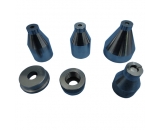






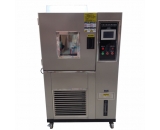





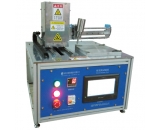
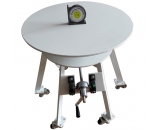
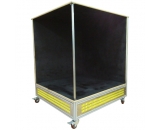

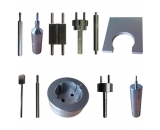



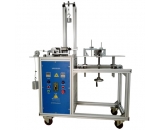

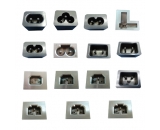





 /2
/2 

